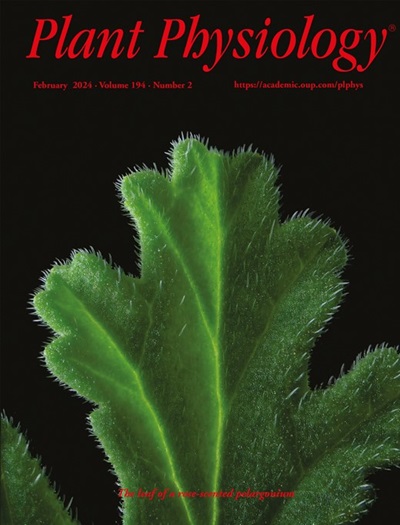miR858a编码的肽miPEP858a与miR858a启动子相互作用,需要c端来实现相关功能
IF 6.5
1区 生物学
Q1 PLANT SCIENCES
引用次数: 0
摘要
MicroRNAs (miRNAs)是基因表达的关键调控因子,通常由初级转录物(pri-miRNAs)加工而成。最近的发现强调,某些pri-miRNA也编码miRNA编码肽(mipep),影响miRNA的功能。然而,miPEP活性的分子机制,包括其功能所需的特定结构域或必需氨基酸残基,在很大程度上仍未被探索。在这项研究中,我们阐明了pri- mir858a衍生的肽miPEP858a直接与拟南芥(拟南芥)MIR858基因的启动子相互作用。值得注意的是,miPEP858a的c端区域由14个氨基酸残基组成,对其功能至关重要。通过dna -蛋白相互作用分析,包括酵母1-杂交、染色质免疫沉淀(ChIP-qPCR)、电泳迁移迁移试验和启动子报告子分析,我们证明了miPEP858a与MIR858启动子内的特定区域结合。外源应用与miPEP858a c端区相对应的合成肽可增强MIR858的表达,导致与全长miPEP858a相似的表型变化。此外,截断的c端肽能够补充缺乏内源miPEP858a的突变植株,强调其在调节miR858a表达以及参与类黄酮生物合成和植物发育的下游靶基因中的作用。这些发现表明,全长miPEP858a可能不是其生物学功能所必需的,c端区域足以调节miRNA的表达。这一发现揭示了鉴定其他mipep的功能域的机会,有可能降低肽合成成本,并提供了一种更有效的策略来提高作物的农艺性状,而不需要复杂的生物技术干预。本文章由计算机程序翻译,如有差异,请以英文原文为准。
miR858a-encoded peptide, miPEP858a, interacts with the miR858a promoter and requires the C-terminus for associated functions
MicroRNAs (miRNAs) are key regulators of gene expression and typically processed from primary transcripts (pri-miRNAs). Recent discoveries highlight that certain pri-miRNAs also encode miRNA-encoded peptides (miPEPs), which influence miRNA function. However, the molecular mechanisms underlying miPEP activity, including the specific domains or essential amino acid residues required for their function, remain largely unexplored. In this study, we elucidated that the pri-miR858a-derived peptide, miPEP858a, directly interacts with the promoter of the MIR858 gene in Arabidopsis (Arabidopsis thaliana). Notably, the C-terminal region of miPEP858a, composed of 14 amino acid residues, is critical for its functionality. Through DNA–protein interaction assays, including yeast 1-hybrid, chromatin immunoprecipitation (ChIP-qPCR), electrophoretic mobility shift assay, and promoter–reporter analyses, we demonstrated that miPEP858a binds to a specific region within the MIR858 promoter. Exogenous application of a synthetic peptide corresponding to the C-terminal region of miPEP858a resulted in enhanced MIR858 expression, leading to phenotypic changes similar to those observed with the full-length miPEP858a. Moreover, the truncated C-terminal peptide was able to complement mutant plants lacking endogenous miPEP858a, emphasizing its role in regulating miR858a expression and downstream target genes involved in flavonoid biosynthesis and plant development. These findings suggest that the full-length miPEP858a may not be necessary for its biological function, with the C-terminal region being sufficient to modulate miRNA expression. This discovery reveals opportunities for identifying functional domains in other miPEPs, potentially reducing peptide synthesis costs, and offering a more efficient strategy for enhancing agronomic traits in crop plants without the need for complex biotechnological interventions.
求助全文
通过发布文献求助,成功后即可免费获取论文全文。
去求助
来源期刊

Plant Physiology
生物-植物科学
CiteScore
12.20
自引率
5.40%
发文量
535
审稿时长
2.3 months
期刊介绍:
Plant Physiology® is a distinguished and highly respected journal with a rich history dating back to its establishment in 1926. It stands as a leading international publication in the field of plant biology, covering a comprehensive range of topics from the molecular and structural aspects of plant life to systems biology and ecophysiology. Recognized as the most highly cited journal in plant sciences, Plant Physiology® is a testament to its commitment to excellence and the dissemination of groundbreaking research.
As the official publication of the American Society of Plant Biologists, Plant Physiology® upholds rigorous peer-review standards, ensuring that the scientific community receives the highest quality research. The journal releases 12 issues annually, providing a steady stream of new findings and insights to its readership.
 求助内容:
求助内容: 应助结果提醒方式:
应助结果提醒方式:


